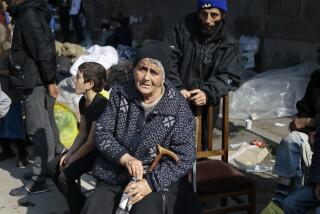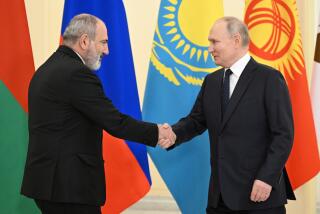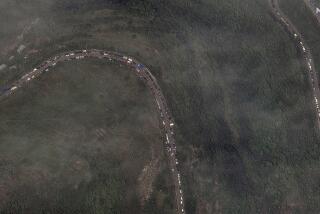Armenians Vote to Leave Soviet Union : Referendum: Small republic overwhelmingly favors independence. Yeltsin mission to solve Nagorno-Karabakh dispute encounters difficulties.
- Share via
YEREVAN, Soviet Union — Amid the jubilation of a brand-new holiday christened Armenian Independence Day, almost 2 million voters in this Caucasus Mountain republic cast their ballots Saturday in favor of breaking away from the Soviet Union.
Although the formal results of the referendum were not available by late Saturday, officials said that more than 85% of those eligible had voted and that the number required for approval--two-thirds of the electorate--was assured.
“Maybe three or four people voted against it,” one Armenian parliamentary deputy joked.
Even as Armenia celebrated, however, efforts to negotiate a settlement of its bloody dispute with the neighboring republic of Azerbaijan encountered new difficulties. At issue is the embattled region of Nagorno-Karabakh, an enclave within predominantly Muslim Azerbaijan that is populated largely by Christian Armenians.
Russian President Boris N. Yeltsin, leading a peace mission to the area, proposed restoring Nagorno-Karabakh to its status as a fully autonomous region--the same status that it had before 1988.
Yeltsin said that Soviet President Mikhail S. Gorbachev has the authority to change Nagorno-Karabakh’s status by presidential decree. But Azerbaijani officials, in opposition to Yeltsin’s proposal, asserted that only their Parliament has the authority to change the region’s status.
Here in Armenia’s capital Saturday, independence and not Nagorno-Karabakh was the first thing on most people’s minds. Armenian President Levon Ter-Petrosyan, anticipating a massive vote for independence, called on foreign leaders to recognize his country’s sovereignty.
“If they don’t recognize it, they will be acting unjustly,” he told reporters at his local polling station Saturday morning.
Ter-Petrosyan said that the Armenian Parliament plans to declare independence Monday and that Armenia would then be open to negotiations for retaining economic and other links--but only as a fully sovereign nation--with the Soviet central government and any other republics that press ahead to full independence.
The Soviet Union recognized the independence of the three Baltic republics--Estonia, Latvia and Lithuania--earlier this month, and eight of the 12 remaining Soviet republics had proclaimed their independence before Saturday. However, Armenia is the first to carry out a referendum on independence according to the requirements of Soviet law.
Throughout the Armenian capital, its pinkish stone buildings bright in the September sun, residents spent Saturday celebrating the referendum’s expected outcome with street music, balloons, speeches and wild motorcades flying the vivid orange, red and blue of the national flag.
On Opera Square in the city center, construction worker Eduard Chakhoyan was already introducing his son and daughter to the new holiday.
“We don’t know the results yet, but we are sure the referendum will pass,” Chakhoyan said. “And from today on, we’ll always have an independence day, and Armenia will be different, and its people will be different too.”
The feeling of freedom, he said, “is like a stone has been lifted off your soul.”
At Elementary School No. 67 in central Yerevan, voting booths were decorated in frilly blue curtains, and the ballot box was decked in satin. By 10 a.m., 400 of the district’s 1,300 voters had already come in. The school’s staff decided to take a breakfast break that looked more like a celebratory feast.
Over bread, fruit and sausage, election commission member Geram Mikaelian raised his glass of smooth Armenian brandy and proposed a toast:
“I want to drink to the collapse of the last empire. And may the entire planet now live free, and everyone be masters of their own rivers and mountains and valleys.”
Aida Kazaryan, the school’s director, said some of the district’s voters had crossed out the “no” on the ballot so hard they had torn through the paper.
Robert Vartanyan, a factory manager, took his grandson to the polling station to prepare him for his future career. “This is the president of Armenia in the year 2010,” he said proudly. “Write his name down--Robert Ovsipyan.”
In the euphoria of the moment, Yerevan’s celebrators put their economic privations out of their thoughts and said the future would inevitably be better than the present.
“Our spiritual independence will be restored,” said Armen Elbakian, director of the republic’s musical comedy theater. “The main thing is not just that there be things on the store shelves, but that a person feel master in his own land.”
Armenia, the smallest of the 12 remaining Soviet republics with a population of only 3.2 million on largely arid land, suffers from typical Soviet food and fuel shortages made worse by frequent blockades on a main railroad supply route that runs through neighboring, hostile Azerbaijan.
But its land reform program is proceeding faster than that in any other republic, with about 70% of available land already given over to private farmers and with the privatization of stores and small enterprises also under way.
“If we’re not oppressed, we’ll be on our feet in five years,” Gabriil Gabriilian, a member of the election committee at School No. 67, said over his brandy. “Not that we’ll be living excellently, but we’ll be stable, at least.”
Political stability, however, will require a settlement of the Nagorno-Karabakh issue. So intense is the dispute that it has cost scores of lives over the past four years and brought Soviet troops to try to keep peace on the border between Armenia and Azerbaijan.
Yeltsin’s peace mission to the area was thrown off schedule in its first full day Saturday. Yeltsin said prolonged discussions with Azerbaijani officials and opposition leaders delayed his departure from Baku, the Azerbaijani capital, for Stepanakert, the major city of Nagorno-Karabakh, and then for Yerevan.
“This is a developing process and not a set program,” Gennady Burbulis, the Russian state secretary and Yeltsin’s closest adviser, told the Soviet news agency Tass in Stepanakert.
There was widespread speculation that Yeltsin, 60, may have suffered a recurrence of the heart condition that kept him from work for two days last week, even though he appeared relatively fit during television interviews and meetings in Baku.
Yeltsin’s peace mission to the area was thrown off schedule in its first full day Saturday. Yeltsin said prolonged discussions with Azerbaijani officials and opposition leaders delayed his departure from Baku, the Azerbaijani capital, for Stepanakert, the major city of Nagorno-Karabakh, and then for Yerevan.
“This is a developing process and not a set program,” Gennady Burbulis, the Russian state secretary and Yeltsin’s closest adviser, told the Soviet news agency Tass in Stepanakert.
There was widespread speculation that Yeltsin, 60, may have suffered a recurrence of the heart condition that kept him from work for two days last week, even though he appeared relatively fit during television interviews and meetings in Baku.
The Tass news agency reported that Yeltsin would make the trip to Stepanakert today (Sunday)and then go on to Yerevan.
Vladimir I. Kirilov, a member of the Soviet Parliament and a Yeltsin envoy in Yerevan, said the discussions in Baku had proved more difficult than expected. The point in question, he said, was not the essence of the proposed settlement but the way it would be put into effect.
Kirilov, who has been working to resolve the dispute for four months, said both Armenia and Azerbaijan are ready to accept the Yeltsin proposal for Nagorno-Karabakh’s return to its old status, but that the leadership of each republic needs to build public support for a difficult compromise on a highly emotional issue.
In Azerbaijan, President Ayaz Mutalibov said this requires a parliamentary debate and approval, according to Russian Television’s evening news program Vesti. In Armenia, this will probably mean delaying the settlement until after the Oct. 16 presidential election.
Kirilov said that Azerbaijan is ready to accept the proposal, which reverses efforts over four years to subdue the enclave.
A Look at Armenia
Here is a brief look at Armenia, the latest republic to declare its independence from Moscow: * LAND: 11,490 square miles in mountainous Transcaucasia.
* PEOPLE: 3.2 million. About 90% are ethnic Armenian.
* ECONOMY: Mining, textiles and agriculture.
* HISTORY: Armenia spent most of the past millennium at the mercy of giant neighbors--Russia, Turkey and Persia--except for a brief flare of independence from 1918 to 1920. In December, 1920, Bolshevik troops occupying Armenia declared it a Soviet republic. It was named a constituent republic of the U.S.S.R. in 1936.
* CURRENT ISSUES: Armenians and Azerbaijanis have disputed the status of Nagorno-Karabakh, an ethnic Armenian enclave completely surrounded by Azerbaijani territory, since 1923. Fighting between Armenian militants and Azerbaijani forces escalated four years ago. More than 800 have died in the battles.
More to Read
Sign up for Essential California
The most important California stories and recommendations in your inbox every morning.
You may occasionally receive promotional content from the Los Angeles Times.













